Effects of Conservation Tillage and Nitrogen Inhibitors on Yield and N2O Emissions for Spring Maize in Northeast China
Abstract
1. Introduction
2. Materials and Methods
2.1. Experimental Site Description
2.2. Experimental Design
2.3. Field Sampling and Laboratory Analysis
2.4. WHCNS Model
2.5. Evaluation of Model Simulation Effect
- (i)
- The normalized root mean squared error (nRMSE):
- (ii)
- Nash–Sutcliffe efficiency (NSE):
- (iii)
- Agreement index (d):
2.6. Simulation Scenarios
2.7. Data Analysis
3. Results
3.1. Model Calibration and Validation
3.2. Effect of Conservation Tillage with Nitrogen Fertilizer Inhibitors on Maize Yield, WUE, and NUE
3.3. Changes in N2O Emissions Under Long-Term Conservation Tillage
3.4. Changes in Crop Yield Under Long-Term Conservation Tillage
4. Discussion
4.1. Effect of Conservation Tillage and NBPT/DMPP on Spring Maize Yield
4.2. Effect of Conservation Tillage and NBPT/DMPP on WUE and NUE
4.3. Effects of Conservation Tillage and NBPT/DMPP on N2O Emissions
5. Conclusions
Supplementary Materials
Author Contributions
Funding
Data Availability Statement
Acknowledgments
Conflicts of Interest
References
- FAO. FAOSTAT; Food and agriculture organization of the United Nations: Rome, Italy, 2015. [Google Scholar]
- Zhang, X.; Davidson, E.A.; Mauzerall, D.L.; Searchinger, T.D.; Dumas, P.; Shen, Y. Managing nitrogen for sustainable development. Nature 2015, 528, 51–59. [Google Scholar] [CrossRef]
- Heikkinen, J.; Ketoja, E.; Nuutinen, V.; Regina, K. Declining trend of carbon in Finnish cropland soils in 1974–2009. Glob. Chang. Biol. 2013, 19, 1456–1469. [Google Scholar] [CrossRef]
- Xie, Y.; Tang, J.; Li, R.F.; Chen, P.Y. Redistribution of SOC driven by erosion and deposition in cultivated black soils of Northeast China. Catena 2025, 258, 109268. [Google Scholar] [CrossRef]
- Yan, B.X.; Yang, Y.H.; Liu, X.T.; Zhang, S.W.; Liu, B.Y.; Shen, B.; Wang, Y.X.; Zheng, G.X. Status and evolution of soil erosion in the black soil region of Northeast China. Soil Water Conserv. China 2008, 12, 26–30, (In Chinese with English abstract). [Google Scholar]
- FAO. Save and Grow. In A policymaker’s Guide to the Sustainable Intensification of Smallholder Crop Production; FAO: Rome, Italy, 2011. [Google Scholar]
- Lipper, L.; Thornton, P.; Campbell, B.M.; Baedeker, T.; Braimoh, A.; Bwalya, M.; Caron, P.; Cattaneo, A.; Garrity, D.; Henry, K. Climate-smart agriculture for food security. Nat. Clim. Change 2014, 4, 1068–1072. [Google Scholar] [CrossRef]
- Wang, M.; Ma, L.; Strokal, M.; Ma, W.; Liu, X.; Kroeze, C. Hotspots for nitrogen and phosphorus losses from food production in China: A county-scale Analysis. Environ. Sci. Technol. 2018, 52, 5782–5791. [Google Scholar] [CrossRef]
- Su, Z.Y.; Zhang, J.S.; Wu, W.L.; Cai, D.X.; Lv, J.J.; Jiang, G.H.; Huang, J.; Gao, J.; Hartmann, R.; Gabriels, D. Effects of conservation tillage practices on winter wheat water-use efficiency and crop yield on the Loess Plateau, China. Agric. Water Manag. 2007, 87, 307–314. [Google Scholar] [CrossRef]
- Wang, Q.J.; Lu, C.Y.; Li, H.W.; He, J.; Khokan, K.S.; Rabi, G.R.; Liang, Z.H.; Qiao, X.D.; Allen, D.J.M. The effects of no-tillage with subsoiling on soil properties and maize yield: 12-Year experiment on alkaline soils of northeast China. Soil Tillage Res. 2014, 137, 43–49. [Google Scholar] [CrossRef]
- Blanco-Canqui, H.; Ruis, S.J. No-tillage and soil physical environment. Geoderma 2018, 326, 164–200. [Google Scholar] [CrossRef]
- Skaalsveen, K.; Ingram, J.; Clarke, L.E. The effect of no-till farming on the soil functions of water purification and retention in North-Western Europe: A literature review. Soil Tillage Res. 2019, 189, 98–109. [Google Scholar] [CrossRef]
- Pittelkow, C.M.; Liang, X.Q.; Linquist, B.A.; Groenigen, K.J.V.; Kessel, C.V. Productivity limits and potentials of the principles of conservation agriculture. Nature 2015, 517, 365–368. [Google Scholar] [CrossRef]
- Huang, Y.; Ren, W.; Wang, L.; Hui, D.; Grove, J.H.; Yang, X.; Tao, B.; Goff, B. Greenhouse gas emissions and crop yield in no-tillage systems: A meta-analysis. Agric. Ecosyst. Environ. 2018, 268, 144–153. [Google Scholar] [CrossRef]
- Farooq, M.; Flower, K.; Jabran, K.; Wahid, A.; Siddique, K. Crop yield and weed management in rainfed conservation agriculture. Soil Tillage Res. 2011, 117, 172–183. [Google Scholar] [CrossRef]
- Xia, L.L.; Li, X.B.; Ma, Q.Q.; Lam, S.K.; Wolf, B.; Kiese, R.; Butterbach-Bahl, K.; Chen, D.L.; Li, Z.A.; Yan, X.Y. Simultaneous quantification of N2, NH3 and N2O emissions from a flooded paddy field under different N fertilization regimes. Glob. Change Biol. 2020, 26, 2292–2303. [Google Scholar] [CrossRef]
- Benjamin, T.; Annette, P.; Michael, B.; Andreas, M.A.; Katrin, D.; Frank, E. Effects of nitrogen fertilization and irrigation on N2O emissions from a sandy soil in Germany. Arch. Agron. Soil Sci. 2015, 61, 569–580. [Google Scholar]
- Bai, J.Z.; Liu, Z.Y.; Song, J.J.; Li, N.; Yu, Q.; Hao, J.Q.; Xu, H.W.; Cheng, B.H.; Wang, X.; Feng, Y.Z. Effects of straw returning and biochar application on summer maize yield and soil N2O emission in Guanzhong Plain. Environ. Sci. 2022, 43, 4379–4386, (In Chinese with English abstract). [Google Scholar]
- Wang, B.; Li, Y.E.; Wan, Y.F.; Qiao, X.B.; Gao, Q.Z.; Liu, S.; Li, J.L. Modifying nitrogen fertilizer practices can reduce greenhouse gas emissions from a Chinese double rice cropping system. Agric. Ecosyst. Environ. 2016, 215, 100–109. [Google Scholar] [CrossRef]
- Dawar, K.; Zaman, M.; Rowarth, J.S.; Blennerhassett, J.; Turnbull, M.H. Urease inhibitor reduces N losses and improves plant-bioavailability of urea applied in fine particle and granular forms under field conditions. Agric. Ecosyst. Environ. 2011, 144, 41–50. [Google Scholar] [CrossRef]
- Misselbrook, T.H.; Cardenas, L.M.; Camp, V.; Thorman, R.E.; Williams, J.R.; Rollett, A.J.; Chambers, B.J. An assessment of nitrification inhibitors to reduce nitrous oxide emissions from UK agriculture. Environ. Res. Lett. 2014, 9, 115006. [Google Scholar] [CrossRef]
- Gilsanz, C.; Bae, Z.D.; Misselbrook, T.H.; Dhanoa, M.S.; Cardenas, L.M. Development of emission factors and efficiency of two nitrification inhibitors, DCD and DMPP. Agric. Ecosyst. Environ. 2016, 216, 1–8. [Google Scholar] [CrossRef]
- Qiao, C.L.; Liu, L.L.; Hu, S.J.; Compoton, J.E.; Greaver, T.L.; Li, Q.L. How inhibiting nitrification affects nitrogen cycle and reduces environmental impacts of anthropogenic nitrogen input. Glob. Chang. Biol. 2015, 21, 1249–1257. [Google Scholar] [CrossRef]
- Liu, J.G.; Chu, Q.Q.; Wang, G.Y.; Chen, F.; Zhang, Y.Y. Simulating yield gap of winter wheat in response to nitrogen management in North China Plain based on DSSAT model. Trans. Chin. Soc. Agric. Eng. 2013, 29, 124–129, (In Chinese with English abstract). [Google Scholar]
- Feng, P.Y.; Wang, B.; Macadam, I.; Taschetto, A.S.; Abram, N.J.; Luo, J.J.; King, A.D.; Chen, Y.; Li, Y.; Liu, D.L.; et al. Increasing dominance of Indian Ocean variability impacts Australian wheat yields. Nat. Food 2022, 3, 862–870. [Google Scholar] [CrossRef]
- Thiault, L.; Mora, C.; Cinner, J.E.; Cheung, W.W.L.; Graham, N.A.J.; Januchowski-Hartley, F.A.; Mouillot, D.; Sumaila, U.R.; Claudet, J. Escaping the perfect storm of simultaneous climate change impacts on agriculture and marine fisheries. Sci. Adv. 2019, 5, eaaw9976. [Google Scholar] [CrossRef]
- Zhang, H.Y.; Hobbie, E.A.; Feng, P.Y.; Niu, L.A.; Hu, K.L. Can conservation agriculture mitigate climate change and reduce environmental impacts for intensive cropping systems in North China Plain? Sci. Total Environ. 2022, 806, 151194. [Google Scholar] [CrossRef]
- Liang, H.; Yang, S.H.; Xu, J.Z.; Hu, K.L. Modeling water consumption, N fates, and rice yield for water-saving and conventional rice production systems. Soil Tillage Res. 2021, 209, 104944. [Google Scholar] [CrossRef]
- Tong, Y.X.; Marcos, E.A.; Yusuf, Y.; Isabel, L. Global black soil distribution. Front. Agricu. Sci. Eng. 2024, 11, 271. [Google Scholar] [CrossRef]
- Zheng, X.; Mei, B.; Wang, Y.; Xie, B.; Wang, Y.; Dong, H.; Xu, H.; Chen, G.; Cai, Z.; Yue, J. Quantification of N2O fluxes from soil–plant systems may be biased by the applied gas chromatograph methodology. Plant Soil 2008, 311, 211–234. [Google Scholar] [CrossRef]
- Liu, X.M.; Huang, Y.F. An experimental study on the application of laser particle sizer to analyze the mechanical composition of soil. Chin. J. Soil Sci. 2005, 4, 579–582, (In Chinese with English abstract). [Google Scholar]
- Liu, D.S.; Li, W.B. Simple method for the determination of soil bulk weight and porosity. Chin. J. Soil Sci. 1983, 4, 44–47, (In Chinese with English abstract). [Google Scholar]
- Schaap, M.G. Rosetta (1.0). 1999. Available online: https://www.handbook60.org/rosetta/ (accessed on 17 May 2022).
- Zelazny, L.W.; He, L.; Vanwormhoudt, A.M. Methods of Soil Analysis, Part 3: Chemical Methods; SSSA Book Series: Madison, WI, USA, 1996. [Google Scholar]
- Allen, R.G.; Pereira, L.S.; Raes, D.; Smith, M. Crop evapotranspiration guidelines for computing crop water requirements. In FAO Irrigation and Drainage Paper; FAO: Rome, Italy, 1998. [Google Scholar]
- Hachum, A.Y.; Alfaro, J.F. Rain infiltration into layered soils: Prediction. J. Irrig. Drain. Div. 1980, 106, 311–319. [Google Scholar] [CrossRef]
- Pachepsky, Y.; Timlin, D.; Rawls, W. Generalized richards’ equation to simulate water transport in unsaturated soils. J. Hydrol. 2003, 272, 3–13. [Google Scholar] [CrossRef]
- Hansen, S.; Abrahamsen, P.; Petersen, C.T.; Styczen, M.E. Daisy: Model use, calibration and validation. Trans. ASABE 2012, 55, 1315–1333. [Google Scholar] [CrossRef]
- Driessen, P.M.; Konijn, N.T. Land use System Analysis; Wageningen Agricultural University: Wageningen, The Netherlands, 1992. [Google Scholar]
- Liang, H.; Hu, K.L.; Batchelor, W.D.; Qi, Z.M.; Li, B.G. An integrated soil-crop system model for water and N management in North China. Sci. Rep. 2016, 6, 25755. [Google Scholar] [CrossRef]
- Liu, S.; Yang, J.Y.; Zhang, X.Y.; Drury, C.F.; Reynolds, W.D.; Hoogenboom, G. Modelling crop yield, soil water content and soil temperature for a soybean-maize under conventional and conservation tillage systems in Northeast China. Agric. Water Manag. 2013, 123, 32–44. [Google Scholar] [CrossRef]
- Yang, J.M.; Yang, J.Y.; Liu, S.; Hoogenboom, G. An evaluation of the statistical methods for testing the performance of crop models with observed data. Agr. Syst. 2014, 127, 81–89. [Google Scholar] [CrossRef]
- Hobbie, E.A.; Grandy, A.S.; Harmon, M.E. Isotopic and compositional evidence for carbon and nitrogen dynamics during wood decomposition by saprotrophic fungi. Fungal Ecol. 2020, 45, 100915. [Google Scholar] [CrossRef]
- Shi, X.R.; Batchelor, W.D.; Liang, H.; Li, S.E.; Li, B.G.; Hu, K.L. Determining optimal water and nitrogen management under different initial soil mineral nitrogen levels in northwest China based on a model approach. Agric. Water Manag. 2020, 234, 106110. [Google Scholar] [CrossRef]
- He, C.; Niu, J.R.; Xu, C.T.; Han, S.W.; Zhang, H.L. Effects of conservation tillage on crop yield and soil organic carbon in Northeast China. Soil Use Manage. 2022, 38, 1146–1161. [Google Scholar] [CrossRef]
- Zheng, K.; He, J.; Li, H.W.; Wang, Q.J.; Li, W.Y. Meta-analysis on maize and wheat yield under subsoiling in Northern China. Trans. Chin. Soc. Agric. Eng. 2015, 31, 7–15, (In Chinese with English abstract). [Google Scholar]
- Liu, Z.; Sun, K.; Liu, W.; Gao, T.; Li, G.; Han, H.; Ning, T. Responses of soil carbon, nitrogen, and wheat and maize productivity to 10 years of decreased nitrogen fertilizer under contrasting tillage systems. Soil Tillage Res. 2020, 196, 104444. [Google Scholar] [CrossRef]
- Cao, L.G.; Zhou, Z.C. Variations of the reference evapotranspiration and aridity index over Northeast China: Changing properties and possible causes. Adv. Meteorol. 2019, 2019, 7692871. [Google Scholar] [CrossRef]
- Li, X.H.; Li, D.P.; Wu, Z.J.; Cui, L.; Xiao, F.R.; Zhang, K.; Li, Y.H.; Zheng, Y.; Zhang, J.M.; Cui, Y.K. Effects of stabilized urea containing NBPT/DMPP/CP on nitrogen use efficiency and maize yield in black and cinnamon soil. Plant Nutr. Fert. Sci. 2021, 27, 957–968, (In Chinese with English abstract). [Google Scholar]
- Martins, M.R.; Sant’Anna, S.A.C.; Zaman, M.; Santos, R.C.; Monteiro, R.C.; Alves, B.J.R.; Jantalia, C.P.; Boddey, R.M.; Urquiaga, S. Strategies for the use of urease and nitrification inhibitors with urea: Impact on N2O and NH3 emissions, fertilizer-15N recovery and maize yield in a tropical soil. Agric. Ecosyst. Environ. 2017, 247, 54–62. [Google Scholar] [CrossRef]
- Zhang, L.; Wu, Z.; Jiang, Y.; Chen, X.; Ma, L. Fate of applied urea 15N in a soil-maize system as affected by urease inhibitor and nitrification inhibitor. Plant Soil Environ. 2010, 56, 8–15. [Google Scholar] [CrossRef]
- Kang, Y.; Khan, S.; Ma, X. Climate change impacts on crop yield, crop water productivity and food security—A review. Prog. Nat. Sci. 2009, 19, 1665–1674. [Google Scholar] [CrossRef]
- Al- Kaisi, M.M.; Douelle, A.; Kwaw- Mensah, D. Soil microaggregate and macroaggregate decay over time and soil carbon change as influenced by different tillage systems. J. Soil Water Conserv. 2014, 69, 574–580. [Google Scholar] [CrossRef]
- Giacomini, S.J.; Machet, J.M.; Boizard, H.; Recous, S. Dynamics and recovery of fertilizer 15N in soil and winter wheat crop under minimum versus conventional tillage. Soil Tillage Res. 2010, 108, 5158. [Google Scholar] [CrossRef]
- Ruisi, P.; Giambalvo, D.; Saia, S.; Giuseppe, D.M.; Alfonso, S.F.; Antonella, P.; Gaetano, A. Conservation tillage in a semiarid Mediterranean environment: Results of 20 years of research. Ital. J. Agron. 2014, 9, 1. [Google Scholar] [CrossRef]
- Grant, C.A.; Derksen, D.A.; McLaren, D.; Irvine, R.B. Nitrogen fertilizer and urease inhibitor effects on canola emergence and yield in a one-pass seeding and fertilizing system. Agron. J. 2010, 102, 875–884. [Google Scholar] [CrossRef]
- Corrochano-Monsalve, M.; Gonzalez-Murua, C.; Bozal-Leorri, A.; Lezama, L.; Artetxe, B. Mechanism of action of nitrification inhibitors based on dimethylpyrazole: A matter of chelation. Sci. Total Environ. 2020, 752, 141885. [Google Scholar] [CrossRef]
- Forte, A.; Fiorentino, N.; Fagnano, M.; Fierro, A. Mitigation impact of minimum tillage on CO2 and N2O emissions from a Mediterranean maize cropped soil under low-water input management. Soil Tillage Res. 2017, 166, 167–178. [Google Scholar] [CrossRef]
- Rochette, P. No-till only increases N2O emissions in poorly- aerated soils. Soil Tillage Res. 2008, 101, 97–100. [Google Scholar] [CrossRef]
- Gregorich, E.G.; Rochette, P.; St-Georges, P.; McKim, U.F.; Chan, C. Tillage effects on N2O emission from soils under corn and soybeans in Eastern Canada. Can. J. Soil Sci. 2008, 88, 153–161. [Google Scholar] [CrossRef]
- Liu, X.J.; Mosier, A.R.; Halvorson, A.D.; Zhang, F.S. The impact of nitrogen placement and tillage on NO, N2O, CH4 and CO2 fluxes from a clay loam soil. Plant Soil 2006, 280, 177–188. [Google Scholar] [CrossRef]
- Ussiri, D.A.; Lal, R.; Jarecki, M.K. Nitrous oxide and methane emissions from long-term tillage under a continuous corn cropping system in Ohio. Soil Tillage Res. 2009, 104, 247–255. [Google Scholar] [CrossRef]
- Venterea, R.T.; Bijesh, M.; Dolan, M.S. Fertilizer source and tillage effects on yield-scaled nitrous oxide emissions in a corn cropping system. J. Environ. Qual. 2011, 40, 1521–1531. [Google Scholar] [CrossRef]
- Zhu, K.; Bruun, S.; Jensen, L.S. Nitrogen transformations in and N2O emissions from soil amended with manure solid and nitrification inhibitor. Eur. J. Soil Sci. 2016, 67, 792–803. [Google Scholar] [CrossRef]
- Mcgeough, K.L.; Watson, C.J.; Müller, C.; Laughlin, J.R.; Chadwick, R.D.; Watson, J.C. Evidence that the efficacy of the nitrification inhibitor dicyandiamide (DCD) is affected by soil properties in UK soils. Soil Biol. Biochem. 2016, 94, 222–232. [Google Scholar] [CrossRef]
- Liu, C.R.; Liu, H.R.; Liu, X.Q.; Zhang, Y.S.; Zang, H.D.; Li, G.; Pan, B.R.; Zhang, M.C.; Li, Z.H. Nitrogen stabilizers mitigate nitrous oxide emissions across maize production areas of China: A multi-agroecosystems evaluation. Eur. J. Agron. 2023, 143, 126692. [Google Scholar] [CrossRef]
- Bremner, J.M.; Mccarty, G.W. Inhibition of Nitrification in Soil by Allelochemicals Derived from Plants and Plant Residues; CRC Press: Boca Raton, FL, USA, 1993. [Google Scholar]
- Chen, W.W.; Zheng, X.H.; Chen, Q.; Wolf, B.; Butterbach-Bahl, K.; Brüggemann, N.; Lin, S. Effects of increasing precipitation and nitrogen deposition on CH4 and N2O fluxes and ecosystem respiration in a degraded steppe in Inner Mongolia, China. Geoderma 2013, 192, 335–340. [Google Scholar] [CrossRef]
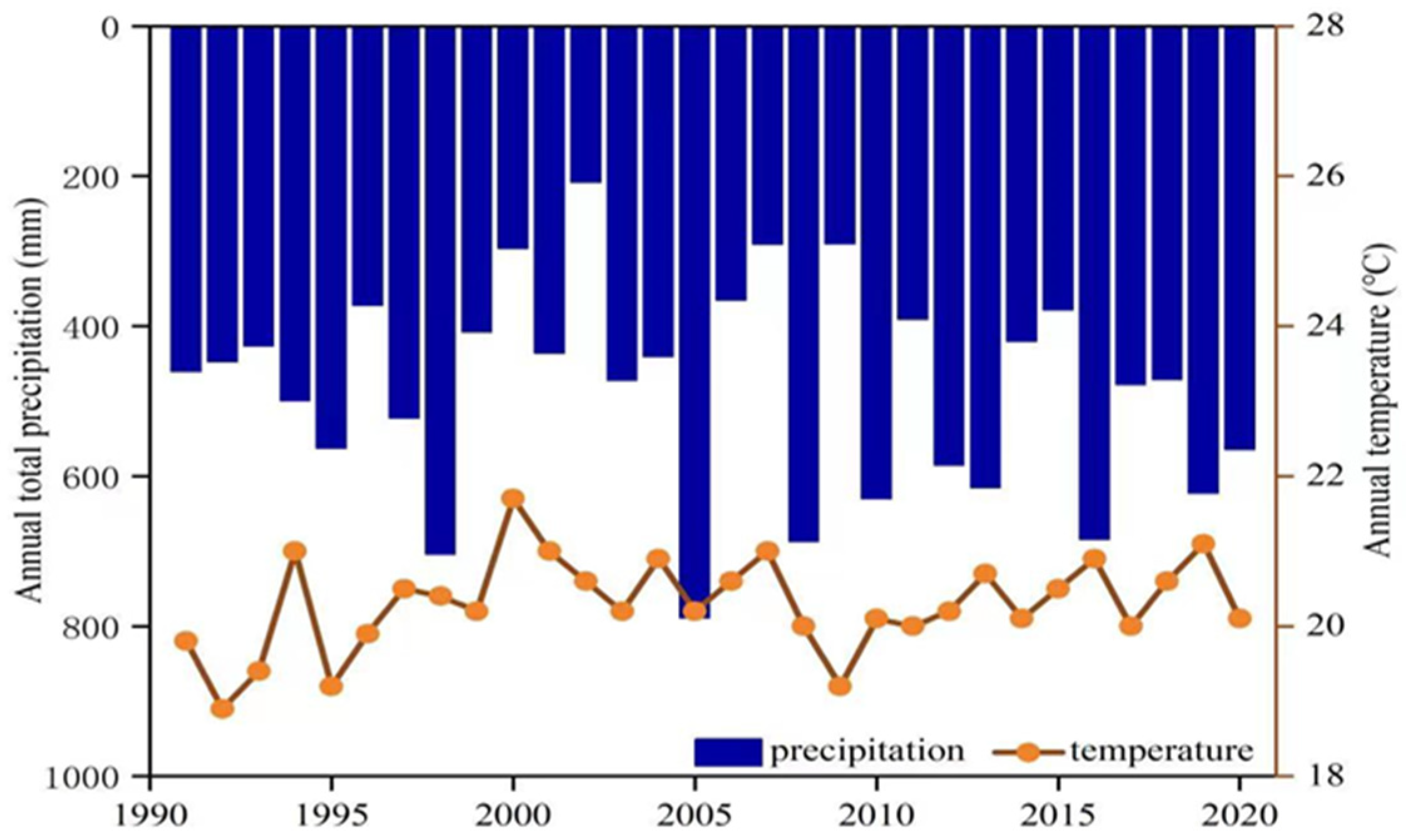
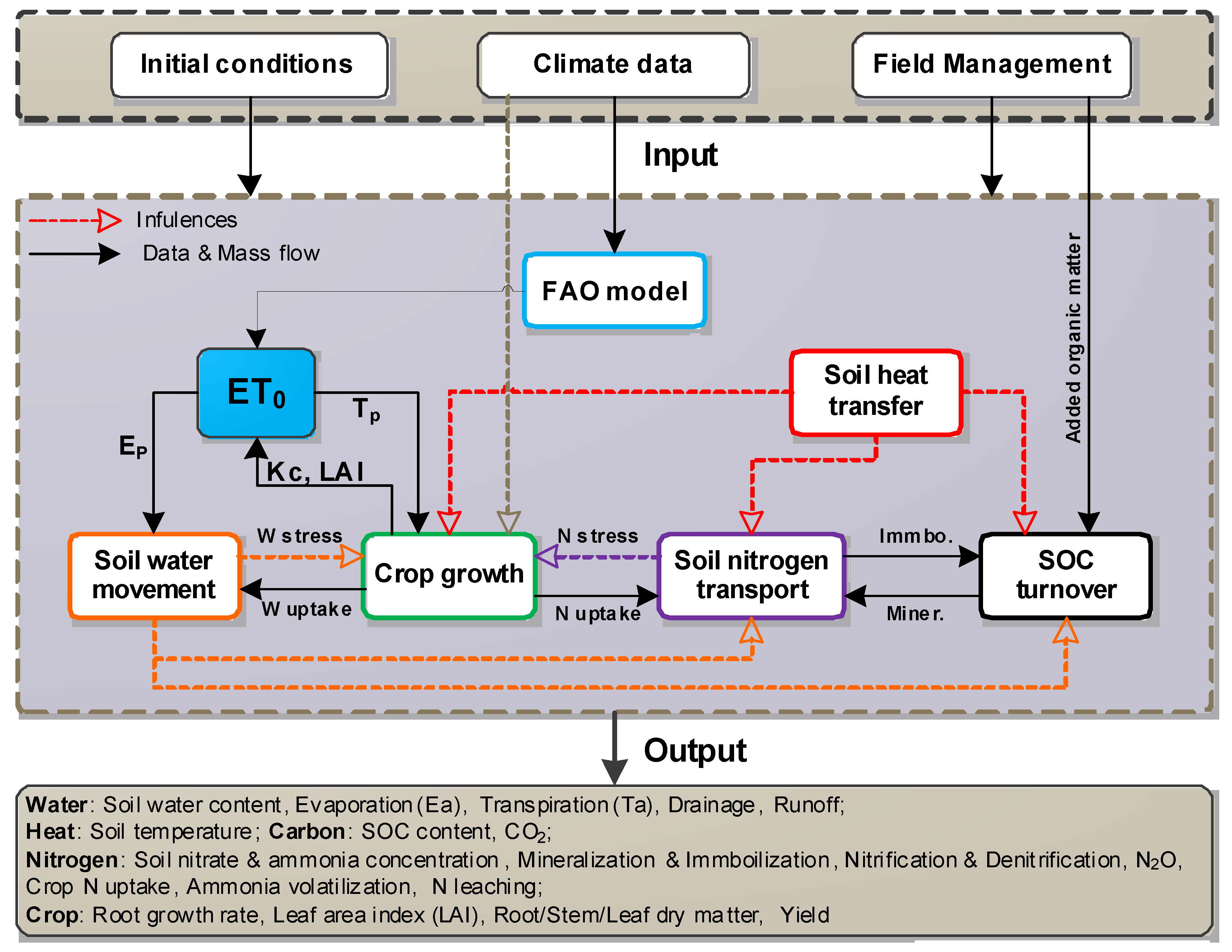
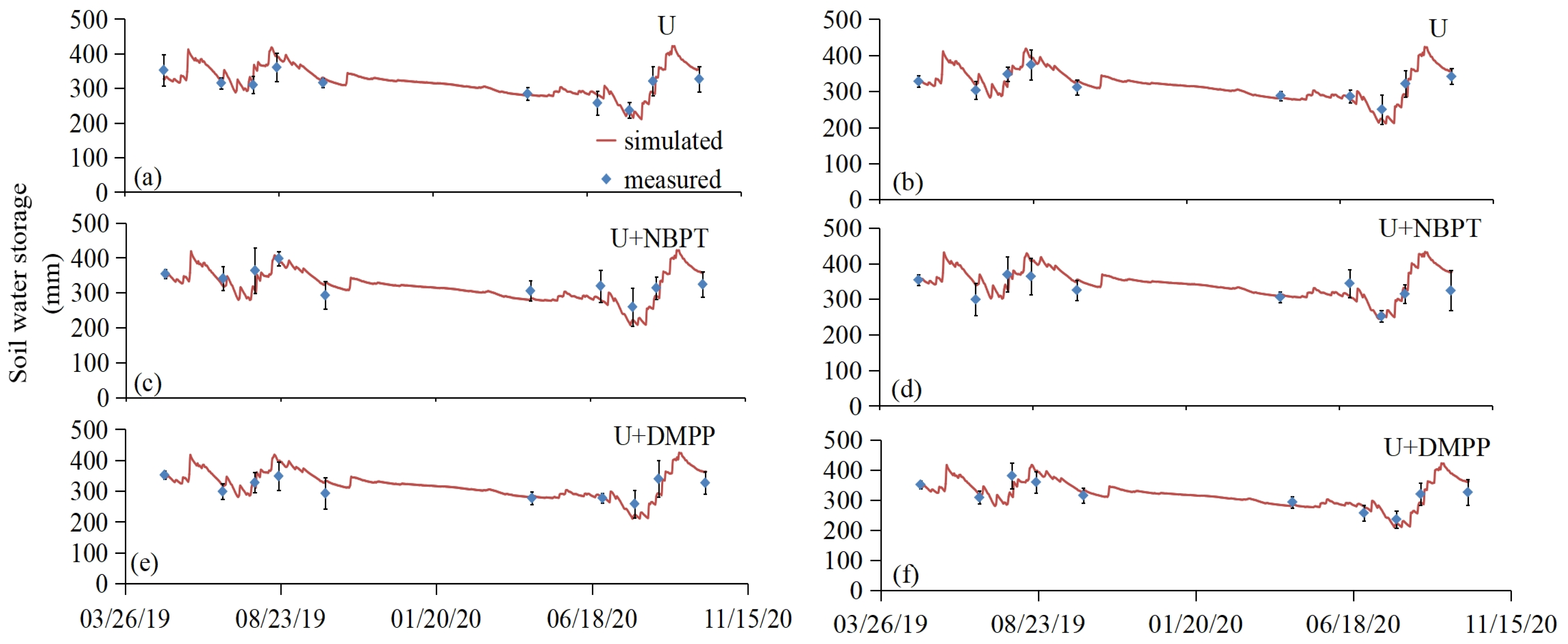
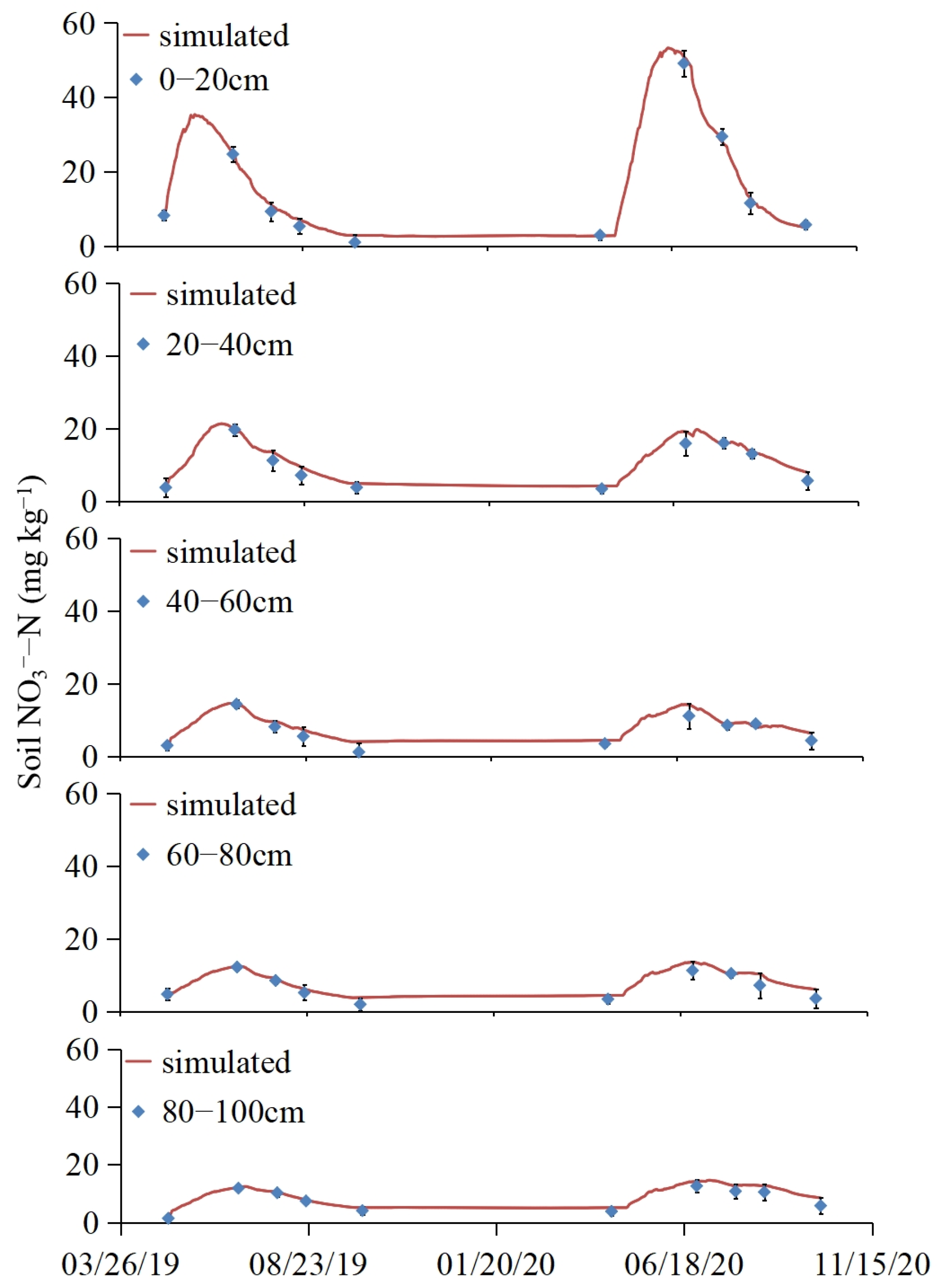
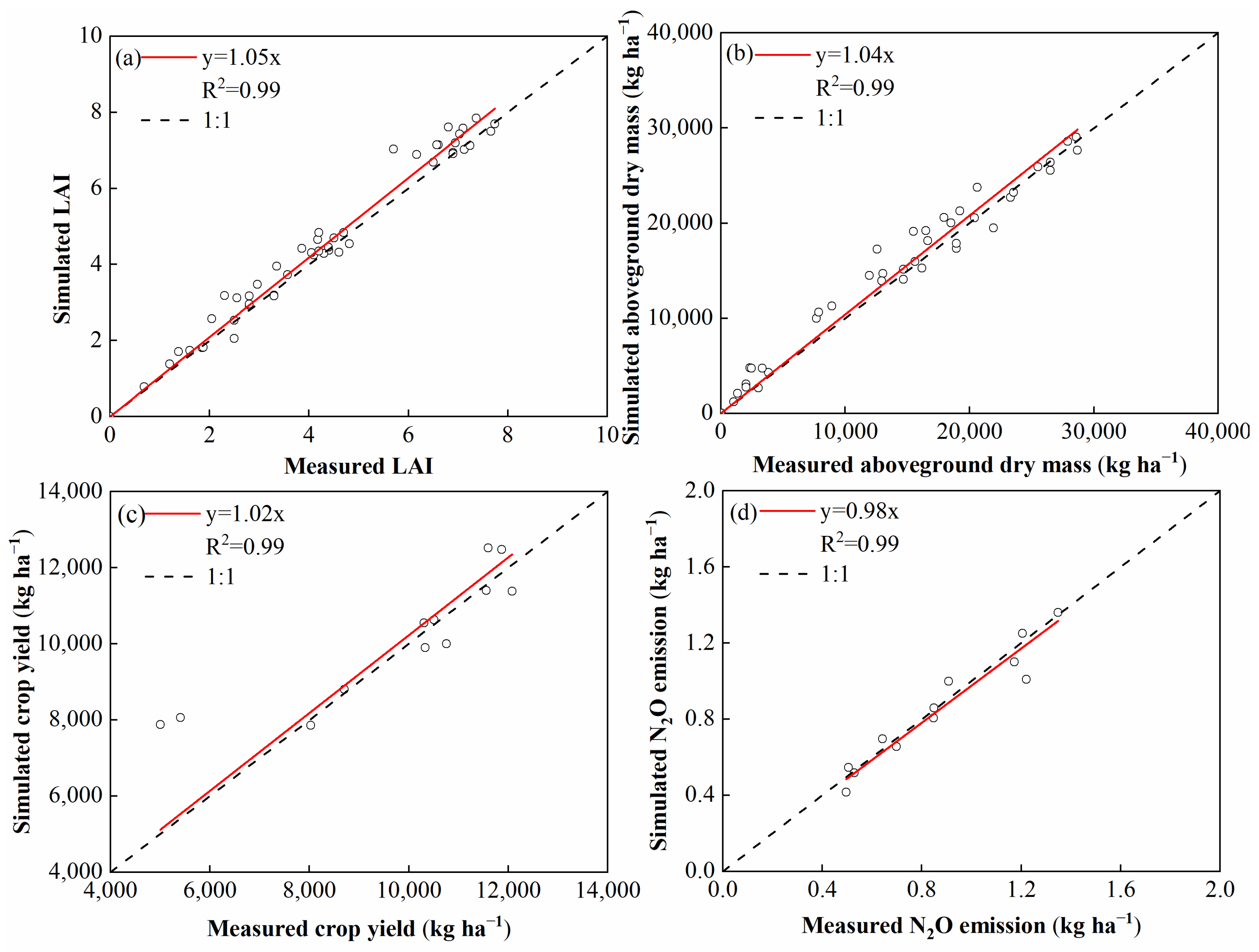

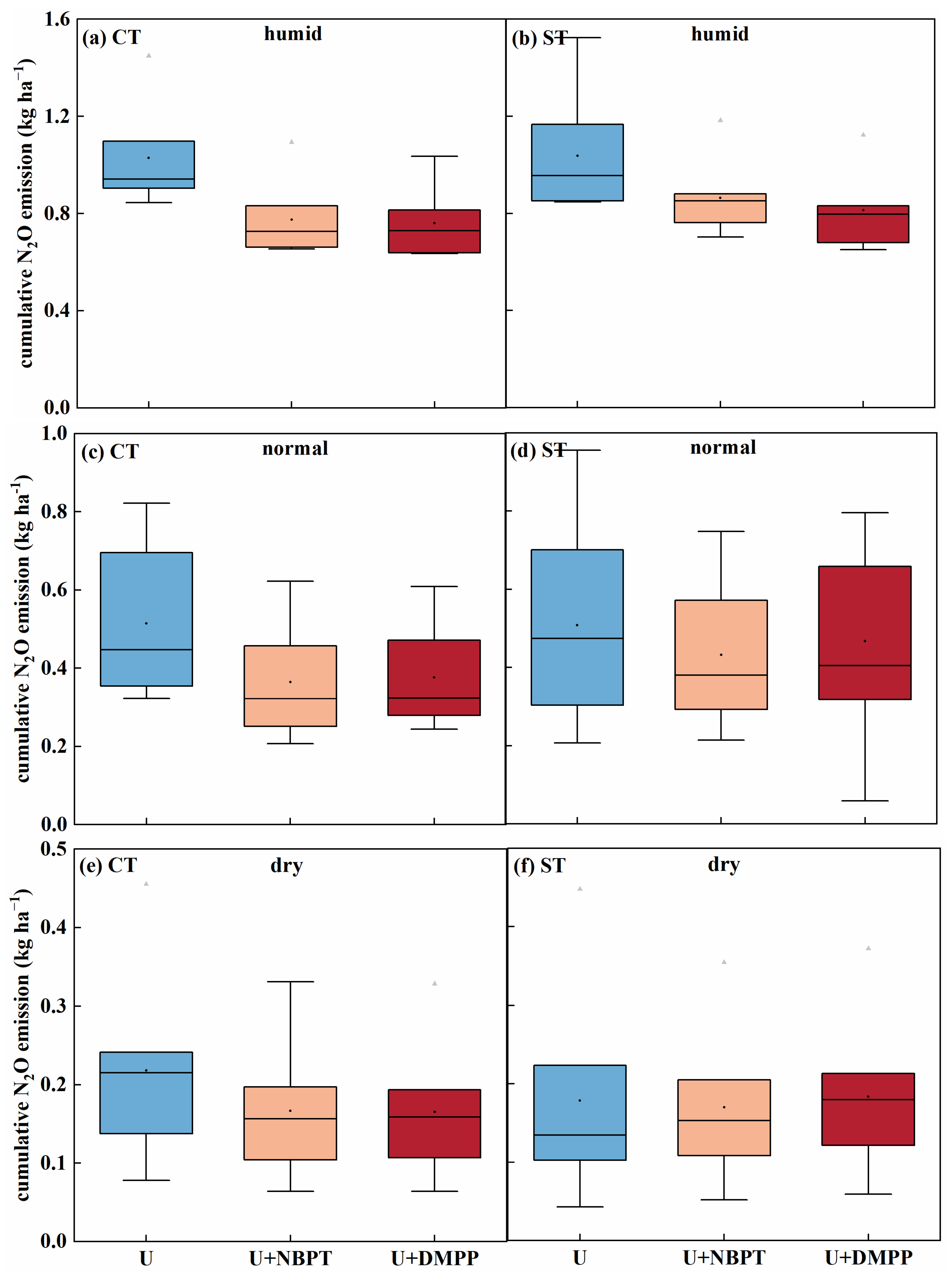
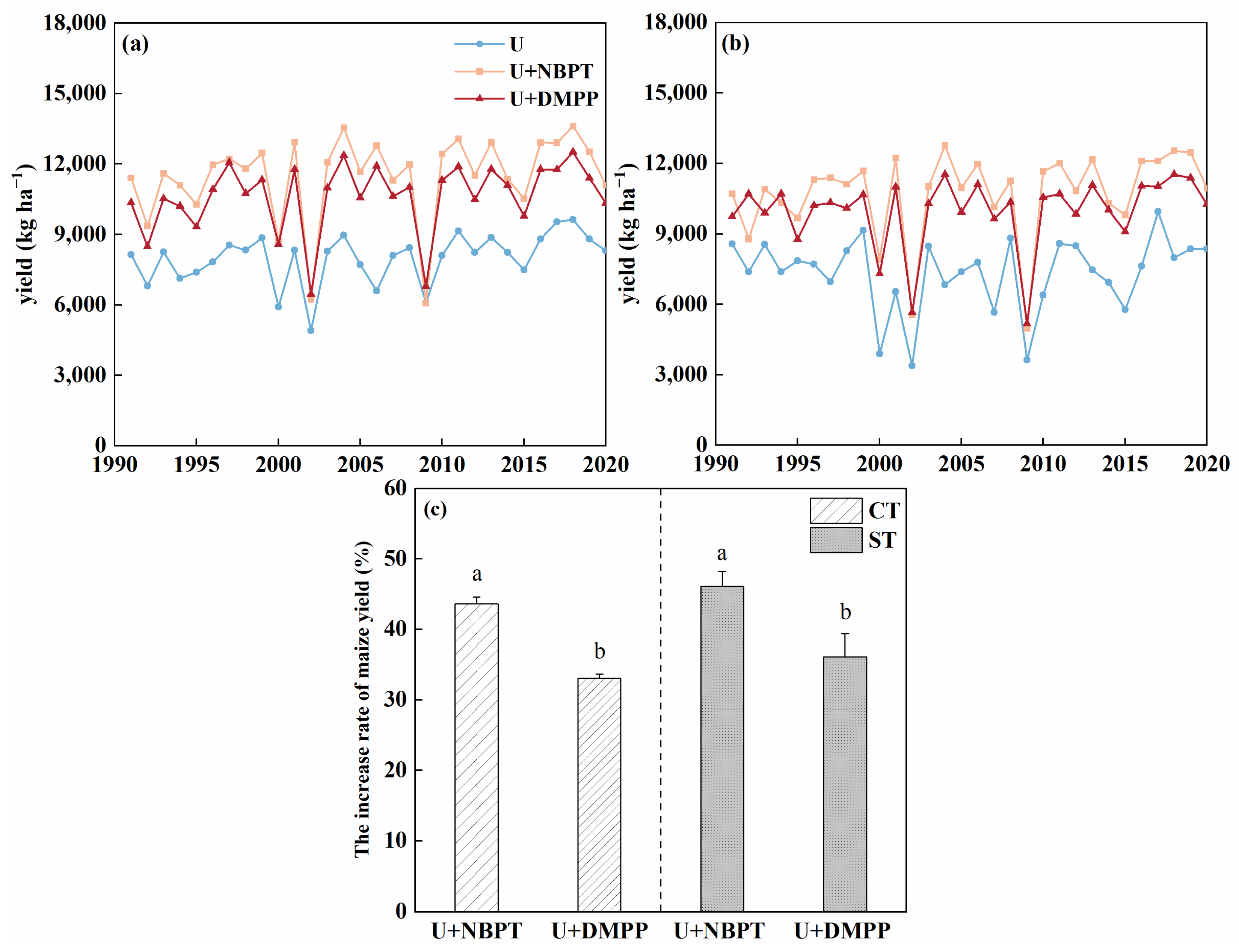
| Soil Layer (cm) | Particle Fraction (%) | Texture (USDA) | BD (g cm−3) | θfc (cm3 cm−3) | θwp (cm3 cm−3) | θs (cm3 cm−3) | Ks (cm d−1) | ||
|---|---|---|---|---|---|---|---|---|---|
| Sand | Silt | Clay | |||||||
| 0–20 | 32.8 | 24.1 | 43.1 | Loamy clay | 1.58 | 0.42 | 0.16 | 0.463 | 2.24 |
| 20–40 | 31.5 | 37.2 | 30.3 | Loamy clay | 1.58 | 0.42 | 0.18 | 0.471 | 4.91 |
| 40–60 | 33.0 | 30.9 | 36.1 | Loamy clay | 1.52 | 0.40 | 0.19 | 0.457 | 4.52 |
| 60–80 | 21.7 | 51.1 | 27.2 | Clay loam | 1.54 | 0.38 | 0.18 | 0.406 | 22.7 |
| 80–100 | 22.0 | 51.5 | 26.5 | Clay loam | 1.60 | 0.39 | 0.19 | 0.426 | 20.9 |
| Treatments | Indexs | Calibration | Validation | ||||
|---|---|---|---|---|---|---|---|
| Soil Water Storage | LAI | ADM | Soil Water Storage | LAI | ADM | ||
| ST | nRMSE% | 8.1 | 13.5 | 15.6 | 9.2 | 19.4 | 18.8 |
| NSE | 0.72 | 0.85 | 0.88 | 0.76 | 0.73 | 0.66 | |
| d | 0.96 | 0.94 | 0.88 | 0.94 | 0.92 | 0.9 | |
| CT | nRMSE% | 9.8 | 22.8 | 14.5 | 10.8 | 20.7 | 20.2 |
| NSE | 0.68 | 0.75 | 0.78 | 0.69 | 0.76 | 0.68 | |
| d | 0.98 | 0.93 | 0.91 | 0.94 | 0.94 | 0.92 | |
| Year | Tillage | Pattern | P | ET | D | R | Wbal | Yield | WUE |
|---|---|---|---|---|---|---|---|---|---|
| (mm) | (mm) | (mm) | (mm) | (mm) | (kg ha−1) | (kg m−3) | |||
| 2019 | ST | U | 623 | 449 a | 142 a | 19 a | 8 a | 8025 a | 1.8 a |
| U + NBPT | 623 | 475 b | 124 b | 19 a | 5 b | 11,865 b | 2.5 b | ||
| U + DMPP | 623 | 467 b | 152 a | 19 a | −15 c | 12,075 b | 2.6 b | ||
| CT | U | 623 | 454 a | 145 a | 19 a | 5 a | 8705 a | 1.9 a | |
| U + NBPT | 623 | 490 b | 136 b | 19 a | −22 b | 11,598 b | 2.4 b | ||
| U + DMPP | 623 | 468 a | 152 a | 19 a | −16 c | 11,556 b | 2.5 b | ||
| 2020 | ST | U | 573 | 365 a | 104 a | 11 a | 98 a | 5412 a | 1.5 a |
| U + NBPT | 573 | 361 a | 122 b | 11 a | 86 b | 10,305 b | 2.9 b | ||
| U + DMPP | 573 | 366 a | 134 b | 11 a | 82 b | 10,326 b | 3.0 b | ||
| CT | U | 573 | 365 a | 111 a | 11 a | 86 a | 5003 a | 1.4 a | |
| U + NBPT | 573 | 372 a | 102 a | 11 a | 89 a | 10,508 b | 2.8 b | ||
| U + DMPP | 573 | 365 a | 108 a | 11 a | 89 a | 10,753 b | 2.9 b |
| Tillage | Pattern | Nfer | Nnet | Nden(N2O) | Nvol | Nlea | Nup | Nbal | NUE |
|---|---|---|---|---|---|---|---|---|---|
| (kg N ha−1) | (kg N ha−1) | (kg N ha−1) | (kg N ha−1) | (kg N ha−1) | (kg N ha−1) | (kg N ha−1) | (kg kg−1) | ||
| 2019ST | U | 180 | 148.0 a | 2.3(0.8) a | 24.0 a | 41.0 a | 147.1 a | 115.0 a | 37.7 a |
| U + NBPT | 180 | 152.9 a | 2.0(0.7) a | 13.9 b | 37.1 a | 185.8 b | 95.4 b | 50.0 b | |
| U + DMPP | 180 | 132.0 b | 1.4(0.5) b | 19.1 c | 33.9 b | 188.7 b | 69.9 c | 49.9 b | |
| 2019CT | U | 180 | 109.8 a | 1.7(0.6) a | 19.3 a | 22.1 a | 156.6 a | 91.2 a | 43.8 a |
| U + NBPT | 180 | 111.2 a | 1.4(0.5) a | 11.2 a | 28.9 b | 202.0 b | 48.5 b | 47.8 a | |
| U + DMPP | 180 | 113.2 a | 1.4(0.5) a | 16.7 c | 24.3 a | 205.8 b | 45.9 b | 46.7 a | |
| 2020ST | U | 180 | 98.3 a | 3.7(1.3) a | 37.1 a | 34.4 a | 128.8 a | 76.7 a | 26.8 a |
| U + NBPT | 180 | 99.7 a | 3.4(1.2) a | 29.8 b | 11.2 b | 165.5 b | 72.0 a | 49.6 b | |
| U + DMPP | 180 | 60.6 b | 2.6(0.9) b | 32.7 b | 2.3 c | 169.4 b | 35.4 b | 50.3 b | |
| 2020CT | U | 180 | 14.2 a | 3.4(1.2) a | 32.2 a | 15.1 a | 134.9 a | 10.9 a | 27.3 a |
| U + NBPT | 180 | 14.8 a | 3.4(1.2) a | 21.8 b | 9.8 b | 177.8 b | −15.8 b | 49.9 b | |
| U + DMPP | 180 | 13.7 a | 2.3(0.8) b | 27.3 c | 0.2 c | 184.7 b | −19.4 c | 50.5 b |
| Term | % Variance | Estimate ± SE | p-Value | VIF |
|---|---|---|---|---|
| Intercept | - | −0.464 ± 0.043 | <0.0001 | - |
| Precipitation(mm) | 46.4 | (209 ± 7.6) × 10−5 | <0.0001 | 1.0 |
| N (NBPT) | 11.2 | −0.15 ± 0.03 | <0.0001 | 1.0 |
| N(DMPP) | 8.2 | −0.11 ± 0.03 | <0.0001 | 1.3 |
| Straw | 8.1 | (5.0 ± 1.0) × 10−5 | <0.0001 | 1.3 |
| Tmin(°C) | 6.1 | (11.0 ± 5.1) × 10−3 | 0.003 | 1.0 |
| Term | % Variance | Estimate ± SE | p-Value | VIF |
|---|---|---|---|---|
| Intercept | - | 5413 ± 476 | <0.0001 | - |
| N (NBPT) | 39.8 | 3808 ± 280 | <0.0001 | 1.3 |
| N (DMPP) | 32.3 | 3807 ± 280 | <0.0001 | 1.3 |
| Precipitation (mm) | 14.1 | 4.6 ± 0.8 | <0.0001 | 1.0 |
| Straw | 7.1 | −0.3 ± 0.1 | 0.006 | 1.0 |
| Tmin (°C) | 6.6 | −143 ± 55 | 0.011 | 1.0 |
Disclaimer/Publisher’s Note: The statements, opinions and data contained in all publications are solely those of the individual author(s) and contributor(s) and not of MDPI and/or the editor(s). MDPI and/or the editor(s) disclaim responsibility for any injury to people or property resulting from any ideas, methods, instructions or products referred to in the content. |
© 2025 by the authors. Licensee MDPI, Basel, Switzerland. This article is an open access article distributed under the terms and conditions of the Creative Commons Attribution (CC BY) license (https://creativecommons.org/licenses/by/4.0/).
Share and Cite
Meng, F.; Feng, G.; Zhang, L.; Wang, Y.; Gao, Q.; Hu, K.; Wang, S. Effects of Conservation Tillage and Nitrogen Inhibitors on Yield and N2O Emissions for Spring Maize in Northeast China. Agronomy 2025, 15, 1818. https://doi.org/10.3390/agronomy15081818
Meng F, Feng G, Zhang L, Wang Y, Gao Q, Hu K, Wang S. Effects of Conservation Tillage and Nitrogen Inhibitors on Yield and N2O Emissions for Spring Maize in Northeast China. Agronomy. 2025; 15(8):1818. https://doi.org/10.3390/agronomy15081818
Chicago/Turabian StyleMeng, Fanchao, Guozhong Feng, Lingchun Zhang, Yin Wang, Qiang Gao, Kelin Hu, and Shaojie Wang. 2025. "Effects of Conservation Tillage and Nitrogen Inhibitors on Yield and N2O Emissions for Spring Maize in Northeast China" Agronomy 15, no. 8: 1818. https://doi.org/10.3390/agronomy15081818
APA StyleMeng, F., Feng, G., Zhang, L., Wang, Y., Gao, Q., Hu, K., & Wang, S. (2025). Effects of Conservation Tillage and Nitrogen Inhibitors on Yield and N2O Emissions for Spring Maize in Northeast China. Agronomy, 15(8), 1818. https://doi.org/10.3390/agronomy15081818







